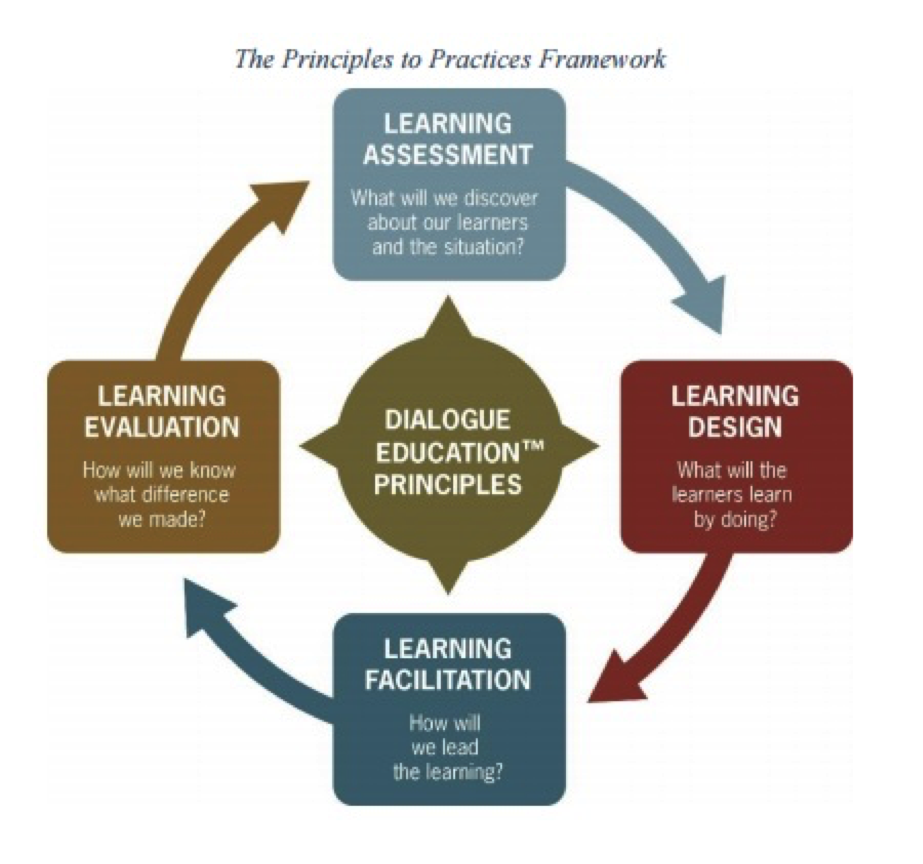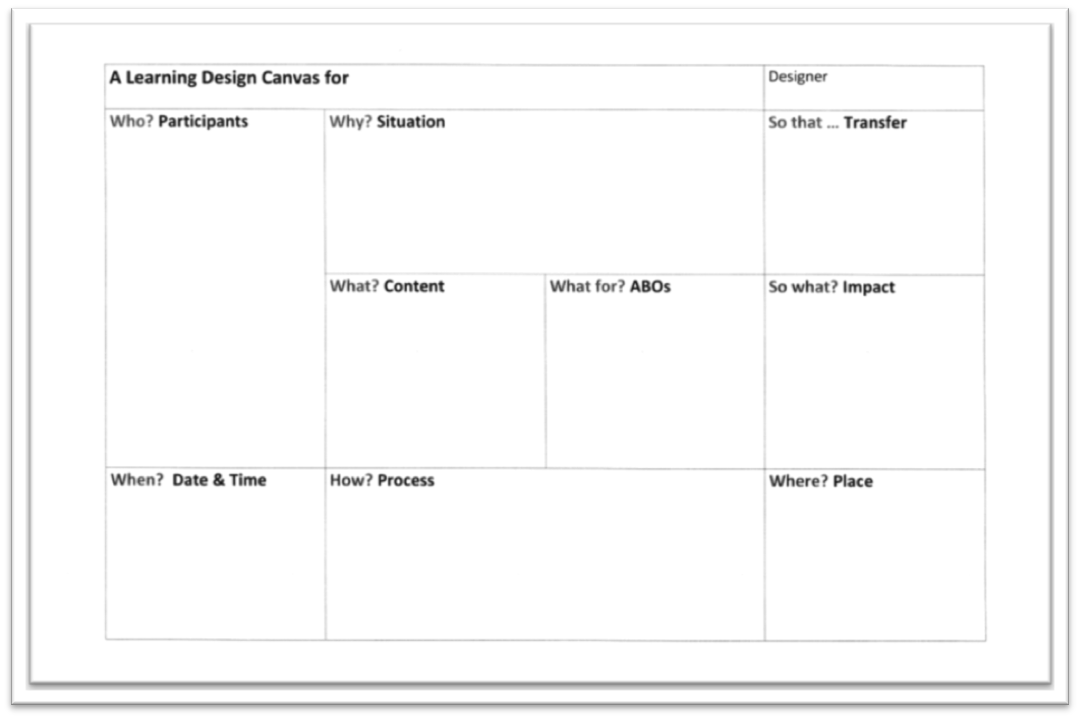Theresa McGauley-Keaney on Dialogue Education, Part 1: A ‘Lean’ Way to Teach and Learn
Hello, I am Theresa McGauley-Keaney, a Program Monitor and Trainer (PMT) at Commonwealth Medicine, a division of the University of Massachusetts Medical School. With a focus on health policy, financing and service delivery in the public interest, we conduct a wide variety of program evaluation and research projects. This is a fast-paced, matrix organization which is employing Lean process improvement methodology (Lean) to its daily work. Separately, my fellow PMTs and I have been using a training methodology called Dialogue Education™ (DE) to add structure and efficiency to our trainings. In this 2-part AEA365 blog, I’d like to explain how my colleagues and I have been using DE and how well we discovered it complements Lean thinking.
The emphasis of DE is on strong training design in order for learners to experience positive, long-term effects of their learning. Shaped by Dr. Jane Vella and drawn from the work of several experts in the fields of education and psychology, DE is a learning-centered training system that values the experience of adult learners. As one of my colleagues summed it up, “DE takes the core principles of adult learning theory and applies them to the development and design of adult trainings.”
Lesson Learned: As trainers, we like DE for its pragmatism, flexibility and for its results. I personally like it because it holds trainers and learners accountable for learning. Through careful design, DE incorporates evaluation into the training on three levels: learning, transfer, and impact. Without learning there will be no transfer, and without transfer there will be no impact. To this point, just one of the many tools DE offers is an Accountability Planner that informs training design by asking:
- Which objectives do you really want and need to evaluate?
- What will the learners do that that you can evaluate?
- Based on your objectives, what do you anticipate changing and what about it are you seeking to evaluate? (learning, transfer or impact)
The Accountability Planner offers the opportunity to consider how learners will apply their learning in their own context. Anticipating and planning for impact allows us to create outcome measures we can use to document results for stakeholders.
Hot Tip: DE uses Achievement-Based Objectives during the training. Make it simple; have learners write on flip charts; or arrange post-it notes. If learners produce it, it can be assessed.
In Part 2, I will discuss how we use DE synergistically with Lean principles for better quality training as we embark on program evaluation and research projects.
Theresa McGauley-Keaney on Dialogue Education, Part 2: A ‘Lean’ Way to Teach and Learn
Hello again, I am Theresa McGauley-Keaney, a Program Monitor and Trainer (PMT) at the University of Massachusetts Medical School’s Commonwealth Medicine. In Part 1, I introduced you to Dialogue Education (DE), a training methodology with a focus on learning. Now I’d like to describe how we find DE complements Lean.
Lean is a performance improvement methodology based on the premise that less waste provides more value for the customer. It adapts the scientific method to process improvement and is grounded in respect for front line workers. Leadership’s role is to support workers to ensure a streamlined flow of efficiency. Like Lean, DE respects adult learners for their knowledge and experience. The trainer’s role is to support the learner. Neither the trainer nor the student is the focus; both are held accountable for learning. In both Lean and DE, people are considered “problem solvers” and are an important part of the process to reach the intended goal.
Lean’s Eight Wastes:
- Defects (errors)
- Overproduction (doing more than needed)
- Waiting (or delays)
- Not utilizing employees (ideas and skills not used)
- Transport
- Inventory (too much material)
- Motion (movement by workers)
- Extra Processing (re-dos, re-work)
Lesson Learned: We find Lean methodologies synergistic in that DE allows us to evaluate the “learning” in our trainings along the way, enabling us to remediate in real-time and avoid re-training (#8). Periodic evaluation intercepts misunderstanding that could lead to passing on bad information (#1). DE utilizes a Learning Needs Resource Assessment that identifies the “required” learning, preventing overproduction (#2), and time wasted teaching people what they already know (#3).
Lesson Learned: My favorite thing about DE is watching people become empowered and motivated by being heard, by instituting their ideas, by being respected, by feeling included and taking ownership (#4).
Lesson Learned: I adapted the Lean A3 size paper report format to the DE Design Steps for consistency, familiarity, and collaboration.
Here is an example of how I used DE to standardize a best practice for security committees across several business units. One or two security liaisons per unit attended my training. I explained why developing a security committee is encouraged and how a charter clarifies structure, function and purpose. Using blank templates, liaisons broke into small groups to share, through dialogue, their ideas and suggestions for each other’s charter. Within one hour, they each had a unit-specific draft charter in hand. They verbalized their intention to show their charters to their unit leadership and discuss implementation. Follow-up revealed that most units now have security committees.
Hot Tip: “Never tell people how to do things. Tell them what to do and they will surprise you with their ingenuity.” General George Patton, Jr.
Do you have questions, concerns, kudos, or content to extend this aea365 contribution? Please add them in the comments section for this post on the aea365 webpage so that we may enrich our community of practice. Would you like to submit an aea365 Tip? Please send a note of interest to aea365@eval.org . aea365 is sponsored by the American Evaluation Association and provides a Tip-a-Day by and for evaluators.



Very nice overview of DE. I like the emphasis that one of the major strengths of DE is its strong design.
I’m saving the well phrased description of the miracle of dialogue:
“My favorite thing about DE is watching people become empowered and motivated by being heard, by instituting their ideas, by being respected, by feeling included and taking ownership.”
Thanks, Theresa! I love being efficient as well as effective in promoting learning. Thanks for sharing how you do this in your work sphere. Knowing and respecting the background, experiences and desires of our learners is such a powerful way of growing and synergizing. Best of wishes as you continue in this pathway!
Thanks Theresa! Would love to hear what types of “muda” you were able to identify and reduce by applying a Dialogue Education approach to teaching and learning. Specifically, what differences were you seeing at the organizational level and what differences did learners report?
I am a Dialogue Education practitioner and love the accountability planner. It ensures that I start working on a project with the end in mind – a concept I love when working for change in the world. When I start a project and the design work with the desired change in mind (from the beginning!) there is a greater chance I will actually get there. Working in this way also makes things easier when it comes time to evaluate: you already know what you will be looking for 🙂 .
Question: I have also been using the 8 steps of design/planning sequence for years and can’t imagine life without it! I have experimented with multiple visual templates for my work but never one like yours. You say it is a “lean” adaptation, and I am curious what makes it so. I don’t see some of the relationships between steps I am used to seeing (and that are important to me), so I would love to hear more about your model.
Thanks!
This was so helpful! Let’s go lean!
Great to see this blog post on how you are synthesizing the Lean and Dialogue Education principles. I especially like the one page summary of the 9 Steps of Design.